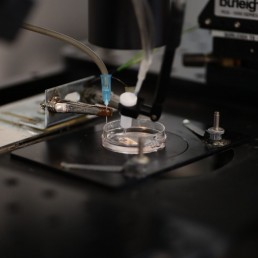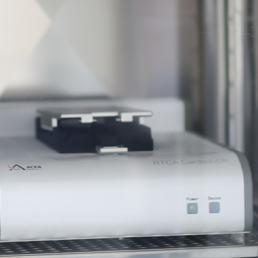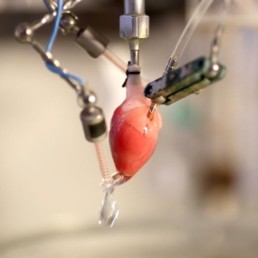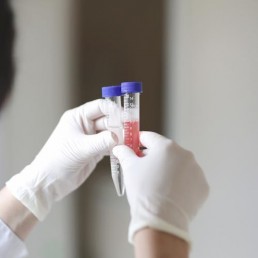Cardiac Ion Channels

CiPA Seven Ion Channels
Physiostim offers you to test your compounds on CiPA cardiac ion channels panel using the automated or manual patch clamp technique. New cardiac safety guidelines are being developed by the Comprehensive in vitro Proarrhythmia Assay (CiPA) initiative from expert working groups: FDA, HESI (Health and Environmental Sciences Institute) and CSRC (Cardiac Safety Research Consortium). One of the main points of CiPA is the profiling of the compounds against a range of cardiac ion channels
All the “CiPA seven” ion channels: hERG* | hNav1.5 peak* | hCav1.2 * | hKvLQT1/MinK | hKir2.1 | hKv4.3 | hNav1.5 late
* = can also be performed under GLP conditions with manual patch clamp technique
hERG
hERG assays are essential to study the cardiovascular safety of a new drug or compound. It’s the pore forming subunit of a potassium ion channel that conducts the rapid component of the delayed rectifier potassium current known as IKr. This ion channel contributes to the repolarization phase of the action potential. When the hERG channel cannot adequately conduct electrical current across the cell membrane, this can result in a potentially fatal disorder called type 2 long QT syndrome (LQT2).
✔ Manual Patch Clamp under GLP conditions
✔ Manual Patch Clamp under non-GLP conditions
✔ Automated Patch Clamp
hNaV1.5 peak
The voltage gated cardiac sodium ion channel Nav1.5, encoded by the SCN5A gene, is a key component for the initiation and transmission of this electrical signal throughout the heart. Its activation induces the depolarization of the cell membrane and initiates the rising phase of the action potential (dV/dtmax). When the Nav1.5 sodium channel cannot adequately conduct the electrical current across the cell membrane, this can result in a potentially fatal ventricular disorder.
✔ Manual Patch Clamp under GLP conditions for hNav1.5 peak only
✔ Manual Patch Clamp under non-GLP conditions
✔ Automated Patch Clamp
hCaV1.2
The voltage gated human Cav1.2 ion channel, encoded by the CACNA1C gene, is a key component of the shape of the plateau phase and is highly implicated in the repolarization process of the action potential. When the Cav1.2 calcium channel cannot adequately conduct electrical current across the cell membrane (delayed inactivation), this may result in undesirable cardiovascular side effects, calcium overload leading to life threatening arrhythmias called earlyafterdepolarizations (EADs) and Torsade de Pointes.
✔ Manual Patch Clamp under GLP conditions
✔ Manual Patch Clamp under non-GLP condition
✔ Automated Patch Clamp
hNaV1.5 late
The α-subunit (Nav1.5) encoded by the SCN5A gene is the predominant element in heart tissue and plays a critical role in the excitability of cardiomyocytes. Nav1.5 channels mediate the inward sodium current (INa) and induce fast depolarization, thereby initiating the excitation–contraction coupling cascades in the cells. INa mediated by Nav1.5 can be classified into peak and late sodium currents (INa-P and INa-L). Mutations of SCN5A can impair Nav1.5 function and change the magnitude and duration of INa-P and INa-L, consequently leading to different types of fatal arrhythmias.
✔ Manual Patch Clamp under non-GLP conditions
✔ Automated Patch Clamp
hKVLQT1/MinK
hKVLQT1/MinK channel encoding for IKs current, plays an important role in the late phase cardiac action potential repolarisation. A pharmacological reduction of the IKs current may delay the repolarisation process and lead to a prolongation of the QT interval. The hKVLQT1/MinK channel is therefore considered as a specific target for cardiac safety assessment.
✔ Manual Patch Clamp under non-GLP conditions
✔ Automated Patch Clamp
hKir2.1
Cardiac inward rectifier potassium (hKir2.1) channels constitute the IK1 channels which are present in all ventricular and atrial myocytes and are important for stabilizing the resting membrane potential. IK1 channels establish the excitation threshold and modulate the final repolarization phase of the action potential (AP) in cardiomyocytes and thus exert profound effects on cardiac excitability and arrhythmogenesis.
✔ Manual Patch Clamp under non-GLP conditions
✔ Automated Patch Clamp
hKV4.3
Since the Kv4.3 channel encoding for Ito current, plays an important role in the early stage of cardiac action potential repolarisation, a pharmacological reduction of the Ito current may delay the repolarisation process and may lead to QT interval prolongation. Thus the Kv4.3 potassium channel represent a specific target for the cardiac safety assessment.
✔ Manual Patch Clamp under non-GLP conditions
✔ Automated Patch Clamp
Ask more information
Additional Cardiac Safety Assays
Need help with your preclinical safety studies?



